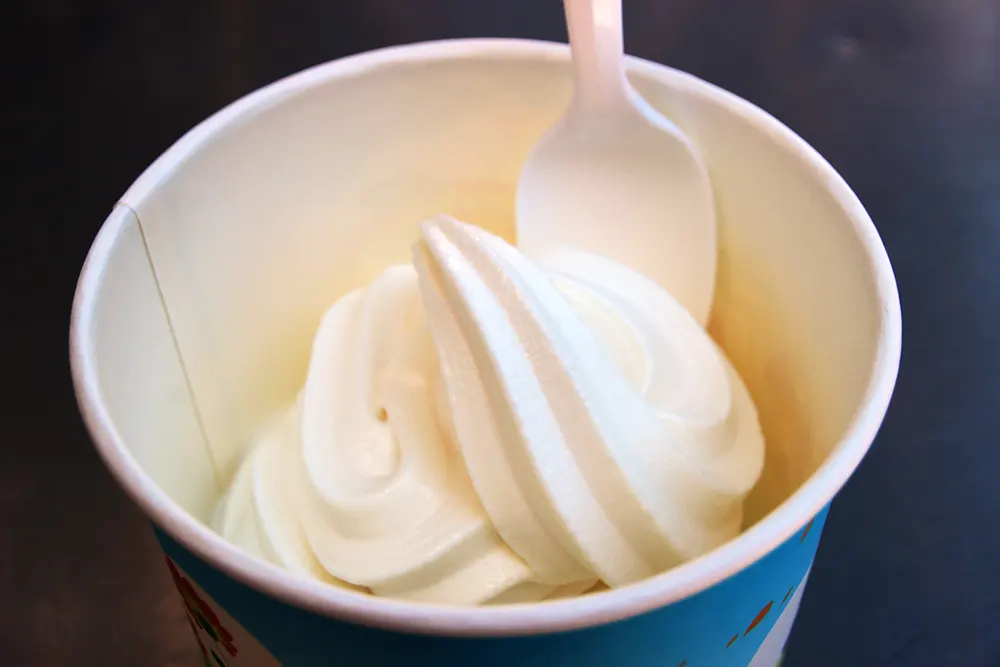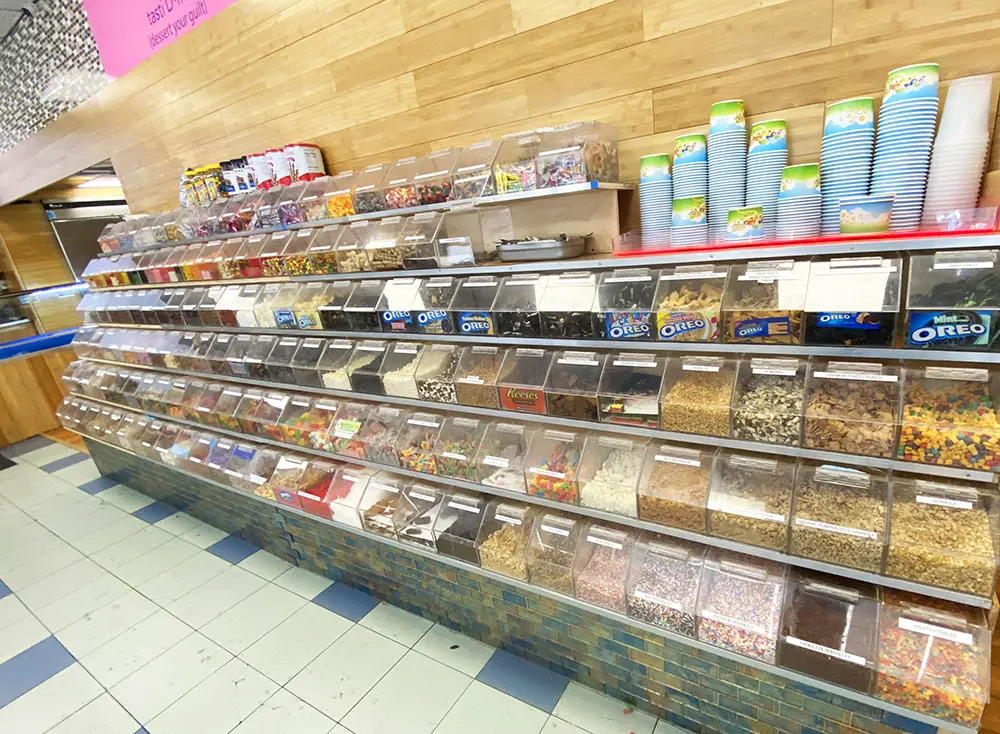The Rise and Fall of Tasti D-Lite: What Happened to New York City’s Favorite Frozen Dessert
By Ian MacAllen on Wednesday, April 17th, 2024 at 2:07 pm

Venerated as a low-cal treat without the compromise of froyo, Tasti D-Lite couldn’t open locations fast enough. Then the venture capitalists promised a global empire.
Frozen yogurt revolutionized sweet, frozen snacks beginning in the 1970s. The product segment quickly grew to be worth hundreds of millions of dollars. But what if you could have the flavor of ice cream, without compromising the health benefits of froyo? Tasti D-Lite promised exactly that. The low calorie frozen treat developed a devout following in New York City, but despite efforts to build a global empire, today there are just two locations remaining.
The first frozen yogurt was created by Boston-based H.P. Hood for a local health food store in 1971. Expectations were low, but proved popular in Beantown, leading Bloomingdale’s to scoop it up for a restaurant and introducing New Yorker’s to Hood’s new product. Carvel Ice Cream, the Westchester company responsible for inventing soft serve ice cream, created their own line of frozen yogurt, Yo Lo, in 1972. At the time, about half of their 630 stores were in the New York metro area, making Carvel instrumental in creating demand for froyo in the city.
The products capitalized on fitness trends and the health conscious consumers worried about counting calories that emerged in the period. By 1981 T.C.B.Y, had opened its first store, invading malls across America. Three years later the chain had more than 100 locations marching steadily toward a peak of more than 3,000. Soon dairy brands like New Jersey-based Tuscan Dairy Farms, yogurt companies like Colombo and Dannon, and ice cream makers like Bronx-founded Haagen-Dazs and Baskin Robbins all offered frozen yogurt desserts. America was crazy for frozen yogurt.
But froyo was not ice cream. The products during the first froyo craze were, according to Jennifer Steinbauer in the New York Times, “cloyingly sweet and chalky.” And that’s why Celeste Carlesimo wanted to create a new product. Assisted by her father, a food scientist, the signature formula for Tasti D-Lite began life in Carlesimo’s kitchen before becoming a sensation many considered a low-calorie miracle.

Tasti, as fans call it, is a whipped, soft-serve, dairy-based frozen dessert. But it is not ice cream–the butter fat content is too low to legally use the term. And while it competed directly with low fat frozen yogurt, it doesn’t contain the active bacteria culture required of yogurt. Tasti D-Lite was an entirely new thing. And it tasted great.
The first store selling Tasti D-Lite launched in 1987 on the Upper East Side of Manhattan. Four ounce servings contained about 100 calories, although this did not include additional toppings like peanuts or candy which were also available. Consumers loved it. By 1992, the New York magazine reported the company had eight stores and was earning more than $100,000 per day.
Carlesimo offered licenses allowing the company to expand. These were not franchises, a distinction that would have consequences later. There was no unified marketing or branding support, and license holders simply owned their own machines and bought Tasti D-Lite product wholesale. The system allowed licensed resellers to retain a great deal of freedom. Tasti machines operated in a variety of locations like bodegas and candy shops, and there was even one Tasti D-Lite license holder who set up in the back of a furniture store. Licensing the product helped Carlesimo grow quickly, but offered little control over the customer experience, and this decision would ultimately haunt the company.

In addition to the base vanilla and chocolate, Carlesimo developed more than 100 flavors. Most shops rotated through popular flavors, adding to the mystique of the product. These flavors would eventually prove to be the firm’s achilles heel. Many included additional ingredients–and unaccounted calories.
One thing did set Carlesimo’s unique formula apart. Tasti D-Lite included real sugar instead of artificial sweetener. That helped with taste. However, to keep calories down, the recipe relied on pumping a high volume of air into the mixture. The process is common among ice cream manufacturers, and the reason cheaper ice cream tends to be lighter by volume. It’s also why ice cream is regulated by fat content–too much air by volume and it’s not ice cream anymore. However, at the licensed shops, the machines that aerated the ice cream often didn’t always inject the same amount of air.
Tasti D-Lite customers also typically served themselves. In most locations, customers filled their bowls and paid by weight. Self-service often resulted in larger portions than the 4 ounces the calorie counts were based on. In 1989, the New York Times launched their first investigation into the health claims of frozen yogurt chains, including Tasti. The paper tested samples of the froyos through independent labs. Most failed their calorie claims, including Tasti D-Lite.

Despite the accusations, customers kept coming. Tasti D-Lite might have been a “scam”, as Environmental Nutrition called the product. But customers kept on swirling it. The Times followed up in 2002, and found the chain, then 35 locations strong, was still undercounting calories.
Even with the calorie controversy, by the early 2000s Tasti D-Lite joined luxury brands like Chanel, Gucci, and Prada in several episodes of “Sex and The City.” Charlotte York and Harry Goldenblatt chowing down on the frozen treat cemented Tasti as a New York icon and further fueled the rabid fanbase. There were other pop culture references in later years, such as a nod from “30 Rock,” and another mention in the film, “The Vow,” but none with the iconic power of “Sex and the City.”
The calorie crisis, however, would simply not go away. Finally, the city’s Department of Consumer Affairs caught up with Tasti D-Lite. In 2005, according to the New York Sun, the chain was fined $100,000, primarily as a penalty for failing to list calorie information for the 121 flavors other than vanilla. The chain was not found in violation of FDA regulations, in part because those allow a generous 20 percent margin of error. Tasti, however, agreed it would no longer be called “low calorie.”
The legal troubles didn’t prevent the company from expanding. Carlesimo started licensing beyond New York City. According to the Hartford Courant, the company started 2005 with licensed shops in New Jersey, Connecticut, Florida, Maryland and Illinois. Carlesimo had so many requests, she even paused new applicants. Once she reorganized two years later, it was to sell the company.
By the mid-2000s, Tasti D-Lite was facing competition from a new generation of frozen yogurt. Pinkberry, originally from L.A., opened in New York in February of 2005, while South Korean import Red Mango followed a few years later, and 16 Handles, a New York City original, was founded in 2008. These next generation froyo shops served a tart-flavored yogurt, embracing the natural acidity rather than chasing the sweetness of ice cream. They heralded a second froyo fad with fanatics lining up, often with shops next door or across the street from each other.
The increased competition didn’t seem to hurt Tasti D-Lite, because in 2007, venture capital firm SPG Partners bought the company and installed James H. Amos as CEO. The new venture had big plans. Amos had made a name for himself expanding Mailboxes Ect and the UPS Store through franchising, and that’s exactly what he planned to do to Tasti D-Lite. He moved the headquarters out of New York to Franklin, Tennessee where he lived, and set to work.
The new Tasti D-Lite launched a franchise program in 2008. The franchise agreements included a lot more control over the look and feel of the stores, and as the program rolled out, the existing license holders were forced to either buy into the franchise, or lose access to the product. The initial fees paid by franchise holders began at $250,000 but could be as much as half a million. These costs might explain why sixteen of the Tasti stores suddenly switched over to become The Lite Choice, an organic, Kosher, froyo alternative similar to Tasti D-Lite.
However, leveraging the franchise system, Tasti D-Lite quickly expanded nationwide signing agreements to bring multiple locations to far-flung cities and states. Franchises opening a single store would often announce the promise to open dozens of nearby locations. The new management also expanded internationally with franchises in South Korea, Mexico, and the United Arab Emirates. One family even negotiated rights to all of Australia.
Despite the rapid expansion of the chain, the organic growth wasn’t fast enough. In late 2011, the company swallowed up Planet Smoothie, a restaurant with more than a hundred franchise locations. At the time, Tasti D-Lite had 60 stores with commitments for 500 more.
To fuel this growth, Amos turned to the then fledgling social media networks to generate hype and fan the flames of customer loyalty. To run this program, he tapped BJ Emerson to spearhead the technology integration. While today nearly every major and minor brand has a social media presence, at the time it was an innovative strategy – one that led the pair to coauthor the book “The Tasti D-Lite Way: Social Media Marketing Lessons for Building Loyalty and a Brand Customers Crave.” The book was meant to highlight their success growing the brand and how social media helped them do it. They focused on Twitter, Facebook, and Yelp, and encouraged each franchise to create local accounts. The book highlighting their accomplishments was published in September of 2012, three months before Amos stepped down as CEO.
Tasti D-Lite and Planet Smoothie continued expanding for the next few years, opening combined stores with both smoothies and machines filled with the whipped dairy product. But the second-wave froyo frenzy was already fading. The days of Pinkberry and Red Mango opening across the street from each other, both with lines out the door, had passed. The expected hundreds of Tasti D-Lite shops never materialized.
By 2015, all the froyo shops everywhere were beginning to suffer, but Tasti D-Lite was perhaps hit hardest. For example, the Washington City Paper noted that while 25 locations were promised in the D.C. metro area, only two had actually opened, and both closed within a year. The story was similar in metro areas around the country.
The brand was in trouble, and in June of that year was scooped up by Kahala Brands, a franchise management company overseeing chains like Blimpie and Stone Cold Creamery. Five months later, the conglomerate would also acquire Pinkberry demonstrating that in restaurant wars, there are no winners.
Today, Google maps is littered with Tasti D-Lite shops listed as permanently closed. Just two of the shops remain, both in Manhattan. However, the company still offers the franchise opportunity.
***
I first had Tasti D-Lite in my 20s from a shop on Third Avenue, not far from the one I visited to take the photos to accompany this story.
After swirling my cup of frozen treat and snapping a few pictures, I dipped the spoon in. Almost two decades had passed since last eating it. I wasn’t sure I wanted to ruin the memory.
I was pleasantly surprised though, to find the creamy vanilla flavor still held up. I would eat this more often, I thought. I watched a steady trickle of customers come in while I was there. The dream of Tasti D-Lite survives.
Locations
416 3rd Ave
New York, NY 10016
1310 First Ave
New York, NY 10021